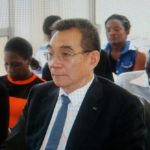The Kampala Sanitation Project is meant to improve sanitation for 1.5 million people in Kampala City and surrounding areas but some activities highlighted in the programme have stalled, with the blame cast on the contractor for failure to provide accurate data for quantities and required costs in the feasibility study.
‘The feasibility studies did not provide accurate data for quantities and required costs. This was exacerbated by the numerous start up challenges’, the African Development Bank, which has provided an extra US$19m loan to finish up the works that first consumed the biggest percentage US$35m AfDB on top of other loans from other donors.
Writing to the Country Manager AfDB Group Uganda Field Office on September 11, 2017, Finance Minister Matia Kasaija requested for the extra US$19m to finish the activities of the project.
In the letter he copied only to Finance Ministry Permanent Secretary, Keith Muhakanizi, Kasaija wrote: ‘The Kampala Sanitation Project (KSP-1) has a shortfall in funding and wish to request for additional funding for successful implementation of the project. This project is vital for the protection of Kampala’s natural environment through control of pollution of Lake Victoria’.
At the time he wrote the letter, Kasaija said that the project was at different stages of implementation. “The Bugolobi Waste Water Treatment Plant is at 86 percent and the Kinawataka Waste Water Pre-treatment Plant is at 30 percent (with expected completion date of April 2018),” he wrote.
The project is being implemented by the National Water and Sewerage Corporation (NWSC). But the extra US$19m will only be available on December 15, 2018 even though the money was approved by the AfDB on December 15, 2017 as shown by AfDB records.
“Since 2016, the program has witnessed accelerated implementation and is in advanced stages of implementation. The additional financing can therefore lead to completion of the outputs and yield benefits to the country in one year,” says the AfDB.
The US$35m AfDB loan to finance the project was approved on December 16, 2008 but the Loan agreement was signed on May 11, 2009 and became effective on February 18, 2010. The total amount disbursed so far as of end of August 2017 is US$32.44m (92.69 percent). But work remains to be done notwithstanding meager funds available.
The Auditor General John Muwanga in his audit report for the year ended June 2014, blamed government for delaying to sign the agreement, leading to the slow implementation of the project. “The loan was declared effective in February 2010, mainly due to delays in the approval processes of Government, i.e.; Cabinet approval, Parliament ratification, Legal Opinion from the Attorney General,” Muwanga wrote in a report on the project.
Design Modifications
According to the Auditor General, the initial design concept for the two Waste Water Treatment Plants for Nakivubo and Kinawataka catchments that had been recommended at the feasibility stage was low-tech, based on the upflow activated sludge blanket in combination with stabilization ponds.
Environmental concerns requiring “odour free” technology became prominent during the detailed design phase and therefore the initial design concept at feasibility had to change from medium technology to high-tech. He said the high-tech WWTP (Waste Water Treatment Plant) introduced much heavier process structures (digesters, sludge holding tanks).
“As a result of this design modification, the foundation of these heavy structures would require extensive soil replacement, filling and consolidation works for the whole site, including concrete piling as foundations for the heavier units. There were initial reservations to the changes in the waste water treatment concept that led to lengthy consultations, and as a result, 9 months were lost before all parties could agree on the treatment technology to be adopted,” Muwanga said in that report.
Financing Challenges
Owing to the changes in the waste water treatment concept from low-tech to high-tech, the programme costs increased. The cost of construction of the Waste Water Treatment Plants escalated from 33 million Euros (at feasibility) to 48.5 million Euros for the Nakivubo Water Treatment Plant (WWTP), while the Kinawataka WWTP costs shot up from 4 million Euros at feasibility to 19.5 million Euros at implementation stage.
Plants Site Location
As part of the final recommendations at the feasibility stage, it was agreed that all new sites for the waste water treatment plants be located at the lowest points possible to enable gravity flow without intermediate pumping or use of siphons. In this regard, the proposed siting of the WWTPs for the four drainage zones/catchment areas for metropolitan Kampala were in the middle of the Nakivubo, Kinawataka, Lubigi and Nalukolongo wetlands.
However, according to officials, the locations are characterised by poor soils which are highly compressible with low bearing capacities. Information obtained on the specific ground conditions obtaining on the proposed site locations (Nakivubo and Kinawataka sites), later established thick layers of highly compressible material of up to 35 meters for the case of Nakivubo. The thickness of this layer had been underestimated at feasibility stage at just 15 meters.
“Being a Design and Build contract, this information only became available when the construction contract had already been awarded. A cost analysis of alternative foundation types established that it would require a minimum of an additional 20 million Euros over and above the 48.5 million Euros to construct Nakivubo WWTP.
NWSC, in consultation with the development partners, agreed to relocate the programme site from Nakivubo to Bugolobi WWTP in order to keep construction costs within manageable levels as they signed the contract in January 20, 2014.
Issues at hand
Reports indicate currently the sewered area of Kampala serves about 7.3% of the population of the city, mainly in the central district business. The sewerage treatment plant that serves the city is located in Bugolobi in Kampala: the Bugolobi sewerage treatment plant which was constructed in the 1940’s and upgraded in 1970 operates as a conventional treatment plant.
Only 55 percent of the sewage generated within the Nakivubo catchment is received at the sewage treatment plant. Owing to technical inadequacies in the sewerage infrastructure, the rest of the sewage ends up into wetlands around Kampala.
Further, majority of residents (92.7 percent) use on-site sanitation systems (septic tanks, pit latrines). However, in most of these areas, particularly in the densely populated slum areas of the city, provision of public and household on-site sanitation is never institutionally supported in terms of operation and maintenance.
Furthermore, cesspool emptier services, which are offered mainly by private sector on a cash-on-demand basis are inadequate. As a result, effluent from latrines and septic tanks are often discharged into the environment untreated.
Also, storm water from the city is largely drained through the Nakivubo open channel. This channel drains into Nakivubo swamp and ultimately into the Inner Murchison Bay of Lake Victoria, which is also the source of abstraction for the drinking water for Kampala.
Studies have shown that the Nakivubo swamp, which is a natural barrier, could offer significant pre-treatment to reduce pollution loading of the channel. However, due to high runoff, the channel has created a deep canal within the swamp, hence flowing undisturbed, straight into the lake.
Still, Kampala city generates about 25,000 tons of solid waste. However only 10 percent of this is collected. The rest of the solid waste is disposed via indiscriminate dumping and finds its way into the Nakivubo channel and /or the sewer network and ultimately into the Inner Murchison Bay. This has exacerbated the sanitation problems faced in the sewerage system and the Lake Victoria.






